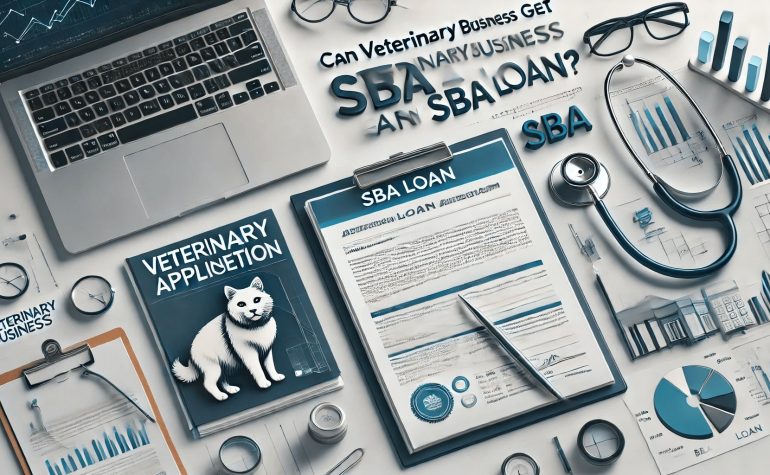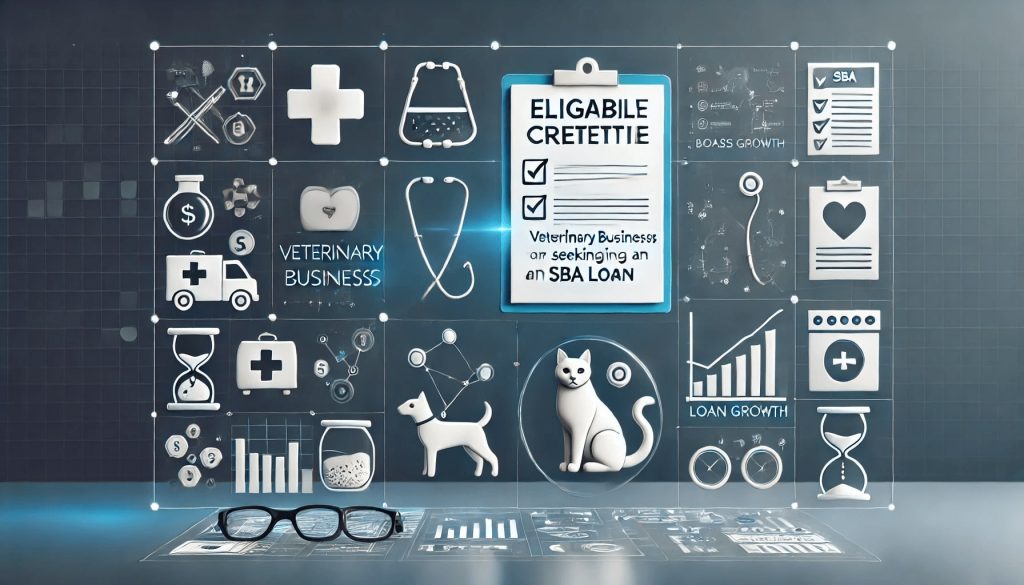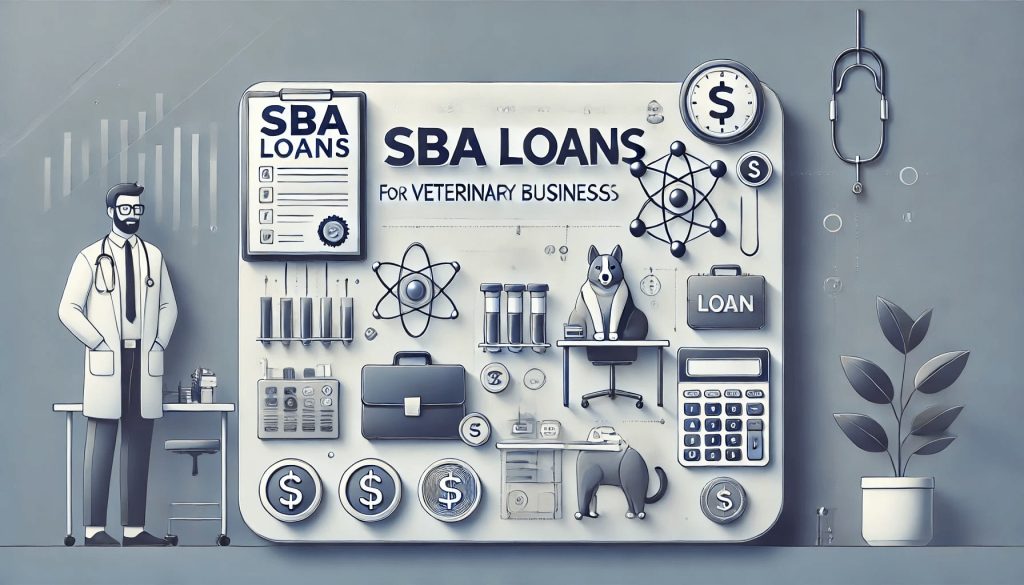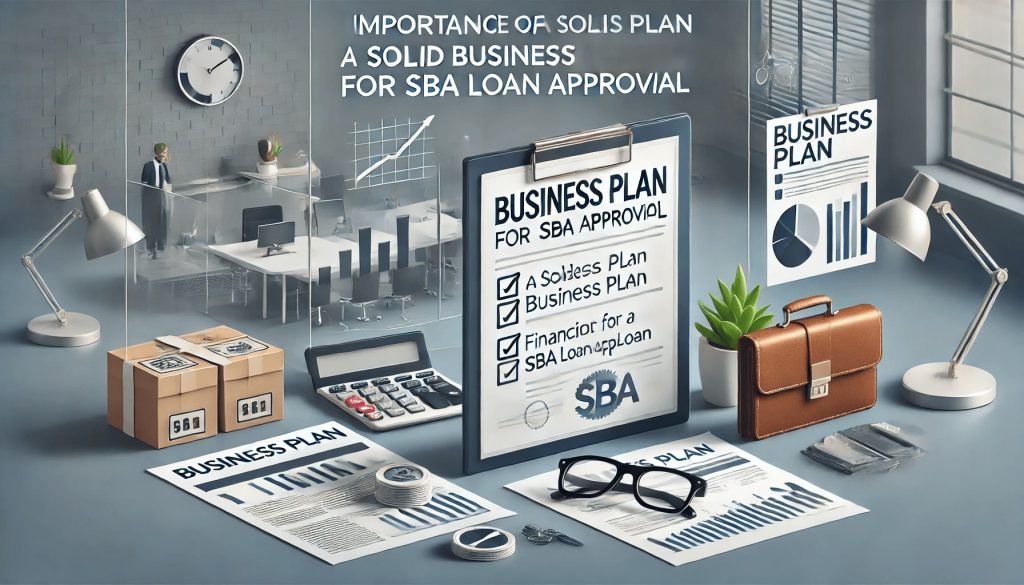
By alphacardprocess October 5, 2024
Starting and running a veterinary business can be a rewarding endeavor, but it often requires a significant amount of capital. Whether you’re looking to expand your existing practice or open a new clinic, securing financing can be a challenge. However, one option that may be available to you is an SBA loan. The Small Business Administration (SBA) offers a variety of loan programs designed to help small businesses, including veterinary practices, access the funding they need to grow and thrive.
In this comprehensive guide, we will explore the eligibility criteria for veterinary businesses seeking an SBA loan, the different types of SBA loans available, and provide a step-by-step guide on how to apply for an SBA loan for your veterinary business. We will also discuss the importance of a solid business plan, tips for improving your business’s creditworthiness, and the collateral requirements and loan terms you can expect when applying for an SBA loan. Finally, we will address some frequently asked questions and conclude with a summary of the key points covered.
Eligibility Criteria for Veterinary Businesses Seeking an SBA Loan

Before diving into the specifics of SBA loans for veterinary businesses, it’s important to understand the eligibility criteria. To qualify for an SBA loan, your veterinary business must meet certain requirements set by the SBA. These requirements include:
- Size Standards: Your veterinary business must meet the SBA’s definition of a small business, which varies depending on the industry. For veterinary practices, the size standards are typically based on the number of employees or annual revenue.
- Legal Structure: Your veterinary business must be organized as a for-profit entity and operate legally within the United States or its territories.
- Good Character: The SBA requires that all owners of the veterinary business have good character, meaning they have not engaged in any criminal activity or unethical business practices.
- Ability to Repay: You must demonstrate the ability to repay the loan by providing financial statements, tax returns, and other relevant documents that show your business’s financial stability and cash flow.
- Use of Funds: The SBA requires that the loan proceeds be used for legitimate business purposes, such as purchasing equipment, expanding the practice, or refinancing existing debt.
Exploring the Different Types of SBA Loans Available for Veterinary Businesses

The SBA offers several loan programs that veterinary businesses can take advantage of. These loan programs provide different terms, interest rates, and loan amounts, allowing you to choose the option that best suits your business’s needs. Let’s explore some of the most popular SBA loan programs for veterinary businesses:
- SBA 7(a) Loan: The SBA 7(a) loan program is the most common and versatile loan program offered by the SBA. It provides funding for a wide range of business purposes, including working capital, equipment purchases, and real estate acquisitions. The loan amounts can range from $50,000 to $5 million, with repayment terms of up to 25 years.
- SBA 504 Loan: The SBA 504 loan program is specifically designed for real estate and equipment purchases. It allows veterinary businesses to finance up to 90% of the total project cost, with loan amounts ranging from $125,000 to $20 million. The repayment terms for the SBA 504 loan are typically 10 or 20 years.
- SBA Microloan: If you’re a small veterinary business in need of a smaller loan amount, the SBA Microloan program may be a suitable option. These loans are provided by nonprofit intermediaries and can range from $500 to $50,000. The repayment terms for SBA Microloans can vary but are typically up to six years.
- SBA Express Loan: The SBA Express loan program offers expedited loan processing and approval, making it an attractive option for veterinary businesses in need of quick funding. The loan amounts can range from $50,000 to $350,000, with repayment terms of up to 25 years.
Step-by-Step Guide: How to Apply for an SBA Loan for Your Veterinary Business
Now that you have a better understanding of the different types of SBA loans available, let’s dive into the step-by-step process of applying for an SBA loan for your veterinary business:
- Determine Your Financing Needs: Before applying for an SBA loan, it’s important to assess your financing needs. Consider how much capital you require, what the funds will be used for, and how long you will need to repay the loan.
- Gather Required Documents: To apply for an SBA loan, you will need to provide various documents, including your business plan, financial statements, tax returns, and personal financial statements for all owners with a 20% or more ownership stake in the business.
- Research Lenders: The SBA does not directly lend money to businesses. Instead, it guarantees a portion of the loan provided by approved lenders. Research and identify lenders in your area that participate in SBA loan programs.
- Prepare Your Business Plan: A solid business plan is crucial when applying for an SBA loan. It should outline your veterinary business’s mission, target market, competition, financial projections, and growth strategies. Be sure to include how the loan funds will be used and how they will benefit your business.
- Complete the Loan Application: Once you have gathered all the necessary documents and prepared your business plan, you can begin the loan application process. Most lenders have their own application forms, but you will also need to complete the SBA’s standard loan application form, known as Form 1919.
- Submit Your Application: After completing the loan application, submit it to your chosen lender along with all the required documents. Be prepared to provide additional information or answer any questions the lender may have during the review process.
- Wait for Approval: The lender will review your application and make a decision on whether to approve or deny your loan request. This process can take several weeks or even months, depending on the lender’s workload and the complexity of your application.
- Loan Closing: If your loan application is approved, you will need to complete the loan closing process. This involves signing the loan agreement, providing any additional documentation requested by the lender, and paying any closing costs or fees associated with the loan.
- Receive Funds: Once the loan closing process is complete, the lender will disburse the loan funds to your veterinary business. Be sure to use the funds for the intended purpose outlined in your loan application.
- Repay the Loan: As with any loan, you will need to make regular payments to repay the loan according to the agreed-upon terms. It’s important to manage your cash flow effectively to ensure timely repayment and maintain a good relationship with the lender.
Understanding the Importance of a Solid Business Plan for SBA Loan Approval

When applying for an SBA loan, having a solid business plan is crucial. A well-crafted business plan not only helps you clarify your goals and strategies but also demonstrates to lenders that you have a clear vision for your veterinary business and a plan for success. Here are some key elements to include in your business plan:
- Executive Summary: Provide a concise overview of your veterinary business, including its mission, target market, and competitive advantage.
- Company Description: Describe your veterinary business in more detail, including its legal structure, location, and any unique features or services you offer.
- Market Analysis: Conduct thorough market research to understand your target market, competition, and industry trends. Identify your ideal clients and explain how your veterinary business will meet their needs.
- Organization and Management: Outline the organizational structure of your veterinary business and introduce key members of your management team. Highlight their qualifications and experience in the veterinary industry.
- Products and Services: Detail the range of products and services your veterinary business offers. Explain how these offerings differentiate you from competitors and provide value to your clients.
- Marketing and Sales Strategy: Describe your marketing and sales strategies for attracting and retaining clients. Include details on your pricing, promotional activities, and customer acquisition plans.
- Financial Projections: Provide realistic financial projections for your veterinary business, including revenue forecasts, expense estimates, and cash flow projections. This will demonstrate to lenders that you have a clear understanding of your business’s financials and its potential for profitability.
- Funding Request: Clearly state the amount of funding you are seeking and how the loan proceeds will be used to support your veterinary business’s growth and success.
- Risk Analysis: Identify potential risks and challenges that your veterinary business may face and explain how you plan to mitigate them. This shows lenders that you have considered potential obstacles and have strategies in place to overcome them.
- Appendices: Include any supporting documents, such as resumes of key team members, market research data, or financial statements, in the appendices section of your business plan.
Tips for Improving Your Veterinary Business’s Creditworthiness for SBA Loan Consideration
When applying for an SBA loan, your veterinary business’s creditworthiness plays a significant role in the lender’s decision-making process. Here are some tips to improve your business’s creditworthiness and increase your chances of securing an SBA loan:
- Establish and Maintain Good Personal Credit: Lenders often consider the personal credit history of the business owners when evaluating loan applications. Make sure your personal credit score is in good standing by paying bills on time, keeping credit card balances low, and avoiding excessive debt.
- Build a Strong Business Credit Profile: Separate your personal and business finances by establishing a separate business bank account and obtaining a federal employer identification number (EIN). Use this EIN to open business credit accounts and make timely payments to build a strong business credit profile.
- Pay Bills on Time: Consistently paying your business’s bills on time demonstrates financial responsibility and improves your creditworthiness. Late payments can negatively impact your credit score and make it more difficult to secure an SBA loan.
- Reduce Debt-to-Income Ratio: Lenders assess your business’s debt-to-income ratio to determine its ability to repay the loan. Reduce your business’s debt by paying off outstanding loans or credit card balances, which will improve your creditworthiness.
- Maintain Accurate Financial Records: Keep detailed and accurate financial records for your veterinary business. This includes maintaining up-to-date balance sheets, income statements, and cash flow statements. Accurate financial records demonstrate your business’s financial stability and help lenders assess its creditworthiness.
- Increase Revenue and Profitability: Lenders want to see that your veterinary business is generating consistent revenue and is profitable. Implement strategies to increase revenue, such as expanding services or attracting new clients, and focus on improving profitability by managing expenses effectively.
- Minimize Outstanding Debt: If your veterinary business has existing debt, such as credit card balances or loans, work towards paying off or reducing these obligations. Lenders prefer businesses with lower levels of outstanding debt, as it reduces the risk associated with the loan.
- Provide Collateral: Offering collateral can increase your chances of securing an SBA loan. Collateral provides lenders with an additional layer of security in case your business is unable to repay the loan. Common forms of collateral include real estate, equipment, or inventory.
Collateral Requirements and Loan Terms for Veterinary Businesses Applying for an SBA Loan
When applying for an SBA loan, collateral requirements and loan terms can vary depending on the loan program and the lender. Here are some key factors to consider:
- Collateral Requirements: The SBA generally requires collateral for loans exceeding $25,000. Collateral can include real estate, equipment, inventory, or other business assets. The value of the collateral must be sufficient to cover a portion of the loan in case of default.
- Personal Guarantees: In addition to collateral, lenders may require personal guarantees from the business owners. A personal guarantee holds the owners personally liable for the loan in case the business is unable to repay it.
- Loan Amounts: The loan amounts available for veterinary businesses can vary depending on the loan program and the lender. SBA 7(a) loans can range from $50,000 to $5 million, while SBA 504 loans can go up to $20 million. SBA Microloans typically range from $500 to $50,000.
- Interest Rates: The interest rates for SBA loans are typically lower than those offered by traditional lenders. The rates can vary depending on the loan program, the lender, and the borrower’s creditworthiness. SBA loans often have fixed interest rates, providing stability and predictability for borrowers.
- Repayment Terms: The repayment terms for SBA loans can range from a few years to several decades, depending on the loan program and the purpose of the loan. SBA 7(a) loans and SBA Express loans typically have repayment terms of up to 25 years, while SBA 504 loans can have terms of 10 or 20 years.
- Use of Funds: SBA loans can be used for a variety of business purposes, including working capital, equipment purchases, real estate acquisitions, and refinancing existing debt. However, it’s important to note that the loan proceeds must be used for legitimate business purposes as outlined in the loan application.
FAQs
Q.1: Can a new veterinary business qualify for an SBA loan?
Yes, new veterinary businesses can qualify for an SBA loan. However, lenders may require additional documentation and financial projections to assess the business’s viability and ability to repay the loan.
Q.2: How long does it take to get approved for an SBA loan?
The approval process for an SBA loan can vary depending on the lender and the complexity of the loan application. It can take anywhere from a few weeks to several months to receive a decision on your loan application.
Q.3: Can I use an SBA loan to purchase an existing veterinary practice?
Yes, SBA loans can be used to finance the purchase of an existing veterinary practice. The loan proceeds can be used for the acquisition cost, working capital, and other legitimate business expenses.
Q.4: What is the maximum loan amount I can get through an SBA loan?
The maximum loan amount for SBA loans depends on the loan program. SBA 7(a) loans can go up to $5 million, SBA 504 loans can reach $20 million, and SBA Microloans typically range from $500 to $50,000.
Conclusion
Securing financing for your veterinary business can be a daunting task, but SBA loans offer a viable solution for many small businesses. By understanding the eligibility criteria, exploring the different types of SBA loans available, and following a step-by-step guide, you can increase your chances of obtaining an SBA loan for your veterinary business.
Remember to create a solid business plan, gather all the necessary documents, and work with an SBA-approved lender to navigate the loan application process successfully. With the right funding in place, you can focus on growing and expanding your veterinary business to provide quality care to your furry patients.